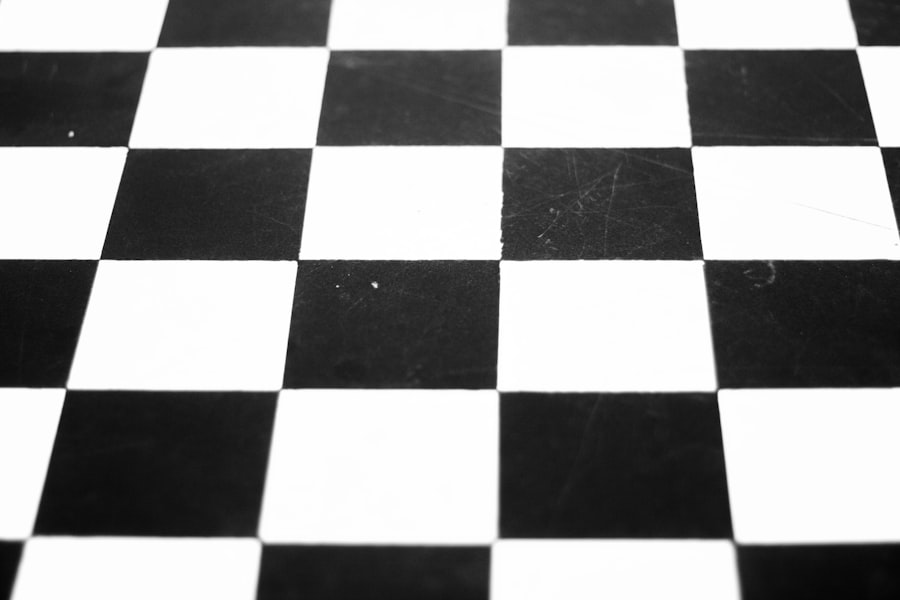Mastering Chess: Strategies for Success
Description
Chess is a game steeped in history, strategy, and intellectual challenge. At its core, chess is played on an 8×8 board, featuring 64 squares of alternating colors. Each player commands an army of 16 pieces: one king, one queen, two rooks, two knights, two bishops, and eight pawns.
This fundamental goal shapes every move and strategy employed throughout the game. The pieces each have unique movements and capabilities.
For instance, the rook moves in straight lines across rows and columns, while the bishop glides diagonally. The knight’s movement is distinctive; it leaps in an “L” shape, allowing it to bypass other pieces. Understanding these movements is crucial for beginners, as it lays the groundwork for more complex strategies.
Additionally, players must grasp the concepts of control over the center of the board, piece development, and king safety. These foundational elements are essential for building a solid chess understanding and will serve as the bedrock for more advanced tactics and strategies.
Key Takeaways
- Understanding the basics of chess is crucial for beginners to grasp the rules and fundamental principles of the game.
- Developing a strong opening repertoire is essential for players to gain an early advantage and control the center of the board.
- Mastering middle game tactics involves understanding key concepts such as pawn structure, piece activity, and creating threats.
- Utilizing endgame techniques is important for converting an advantage into a win and understanding key endgame principles such as king activity and pawn promotion.
- Improving calculation and visualization skills is crucial for accurately assessing positions and finding the best moves in complex positions.
Developing a Strong Opening Repertoire
A well-structured opening repertoire is vital for any chess player aiming to improve their game. The opening phase sets the tone for the entire match, establishing control over the board and preparing for the middle game. Players often choose openings based on their style—aggressive players might favor sharp lines like the Sicilian Defense, while more positional players may lean towards the Queen’s Gambit.
Familiarity with various openings allows players to navigate the initial moves confidently and avoid falling into traps set by their opponents. To develop a strong opening repertoire, players should study a variety of openings and understand their underlying principles rather than memorizing moves blindly. For example, in the Ruy Lopez, White aims to control the center with 1.e4 and 2.Nf3 before playing 3.Bb5 to put pressure on Black’s knight on c6.
Understanding why these moves are made helps players adapt when their opponents deviate from known lines. Additionally, players should analyze their own games to identify which openings yield favorable positions and which lead to difficulties. This self-reflection is crucial for refining one’s repertoire over time.
Mastering Middle Game Tactics

The middle game is where chess truly comes alive, filled with tactical opportunities and strategic maneuvering. This phase often arises after the opening has concluded, with both players having developed their pieces and established their plans. Mastering middle game tactics involves recognizing patterns and combinations that can lead to material gain or positional advantages.
Tactics such as forks, pins, skewers, and discovered attacks are essential tools in a player’s arsenal. For instance, a fork occurs when a single piece attacks two or more of the opponent’s pieces simultaneously, forcing them to choose which piece to save. A classic example is a knight fork where a knight simultaneously attacks a king and a rook.
Recognizing these tactical motifs requires practice and familiarity with common patterns. Players can enhance their tactical skills by solving puzzles and engaging in tactical training exercises that challenge them to find the best moves in various positions. This practice not only sharpens their tactical vision but also builds confidence in their ability to navigate complex middle game scenarios.
Utilizing Endgame Techniques
| Endgame Technique | Definition | Example |
|---|---|---|
| Zugzwang | Forcing the opponent to make a disadvantageous move. | Position where any move will worsen the opponent’s position. |
| Opposition | Placing the kings directly opposite each other with an odd number of squares between them. | Using the kings to control key squares and advance pawns. |
| Triangulation | Wasting a move to put the opponent in a worse position. | Creating a position where the opponent is forced to move into a disadvantageous position. |
The endgame is often considered one of the most critical phases of chess, where precise technique can turn a slight advantage into victory or salvage a draw from a losing position. In this phase, fewer pieces remain on the board, making every move count significantly more than in earlier stages. Understanding key endgame principles—such as king activity, pawn promotion, and opposition—is essential for converting advantages into wins or defending against threats.
One fundamental concept in endgames is the importance of activating the king. Unlike in the opening and middle game where the king’s safety is paramount, in the endgame, the king becomes a powerful piece that can influence pawn structures and support other pieces. For example, in a king and pawn endgame, having an active king can mean the difference between promoting a pawn or allowing the opponent to do so first.
Players should also familiarize themselves with common endgame scenarios such as king and pawn versus king or rook versus pawn endings. Studying these positions helps players recognize winning techniques and defensive resources that can be employed during actual games.
Improving Calculation and Visualization Skills
Calculation and visualization are two critical skills that every chess player must develop to excel at the game. Calculation refers to the ability to foresee potential moves and their consequences several turns ahead, while visualization involves mentally picturing positions without needing a physical board. These skills are intertwined; strong visualization enhances calculation abilities by allowing players to track multiple variations simultaneously.
To improve calculation skills, players should practice analyzing positions deeply before making decisions. This involves considering not just immediate threats but also potential responses from the opponent. For example, when contemplating a sacrifice, a player must calculate not only the immediate benefits but also how the opponent can respond in subsequent moves.
Studying Grandmaster Games

Learning from the Best
One of the most effective ways to improve at chess is by studying games played by grandmasters. These elite players often demonstrate advanced strategies and tactics that can provide valuable insights into high-level play. Analyzing grandmaster games allows players to see how top competitors handle various openings, navigate complex middle games, and execute endgame techniques with precision.
Focused Analysis for Deeper Understanding
When studying grandmaster games, it’s beneficial to focus on specific themes or concepts rather than merely replaying moves. For instance, one might analyze how a grandmaster transitions from an opening into a middle game or how they handle pawn structures in different positions. Resources such as databases of grandmaster games or annotated books can provide context and explanations for critical decisions made during play.
Applying Grandmaster Strategies to Your Own Games
By understanding the reasoning behind each move, players can incorporate similar ideas into their own games. This approach enables chess enthusiasts to elevate their skills and make more informed decisions during their own matches.
Enhancing Strategic Planning and Positional Understanding
Strategic planning is an essential aspect of chess that goes beyond immediate tactics; it involves long-term goals and positional considerations that shape a player’s approach throughout the game. A strong strategic plan takes into account factors such as piece activity, pawn structure, control of key squares, and weaknesses in the opponent’s position. Developing this understanding requires both theoretical knowledge and practical experience.
For example, controlling open files with rooks can be a powerful strategic goal that allows for increased pressure on the opponent’s position. Similarly, creating pawn majorities on one side of the board can lead to advantageous endgames where one side can promote pawns more effectively than the other. Players should strive to evaluate positions holistically rather than focusing solely on material count or immediate threats.
Engaging in discussions with stronger players or coaches about strategic ideas can further enhance one’s understanding of positional play.
Practicing and Analyzing Games for Improvement
Regular practice is crucial for any chess player seeking improvement; however, simply playing games is not enough. Analyzing one’s own games post-play is equally important as it provides insights into mistakes made during play and areas for improvement. This reflective practice allows players to identify recurring patterns in their decision-making processes—both strengths and weaknesses.
Using software tools or online platforms that offer analysis features can greatly aid this process by highlighting blunders or missed opportunities during games. Players should take time to review critical moments where they felt uncertain or made suboptimal moves. Additionally, discussing games with peers or coaches can provide alternative perspectives on decision-making processes and strategies employed during play.
By consistently practicing and analyzing games, players can foster continuous growth in their chess abilities while developing a deeper understanding of both their own style and that of their opponents.
If you’re a fan of chess, you may also be interested in learning about the most viewed apps in 2025. Check out the article here to see what apps are trending and how they can enhance your chess playing experience.
FAQs
What is chess?
Chess is a two-player strategy board game that is played on an 8×8 grid. It is one of the most popular and enduring games in the world, with a rich history dating back over 1500 years.
How is chess played?
Chess is played on a square board divided into 64 squares of alternating colors. Each player starts with 16 pieces: one king, one queen, two rooks, two knights, two bishops, and eight pawns. The objective of the game is to checkmate the opponent’s king, which means putting the king into a position where it cannot escape capture.
What are the basic rules of chess?
Each type of chess piece moves in a specific way: the king moves one square in any direction, the queen moves any number of squares in any direction, the rook moves any number of squares horizontally or vertically, the bishop moves any number of squares diagonally, the knight moves in an L-shape, and the pawn moves forward one square but captures diagonally. Players take turns moving their pieces, and the game ends when one player’s king is in checkmate.
What are the benefits of playing chess?
Chess has been shown to have numerous cognitive benefits, including improving memory, concentration, problem-solving skills, and strategic thinking. It is also a great way to improve patience and decision-making abilities.
What is the history of chess?
Chess originated in India around the 6th century and spread to Persia, where it became known as “shatranj.” It then spread to the Arab world and Europe, evolving into the modern game of chess that we know today. Chess has a rich and storied history, with many famous players and memorable games throughout the centuries.





